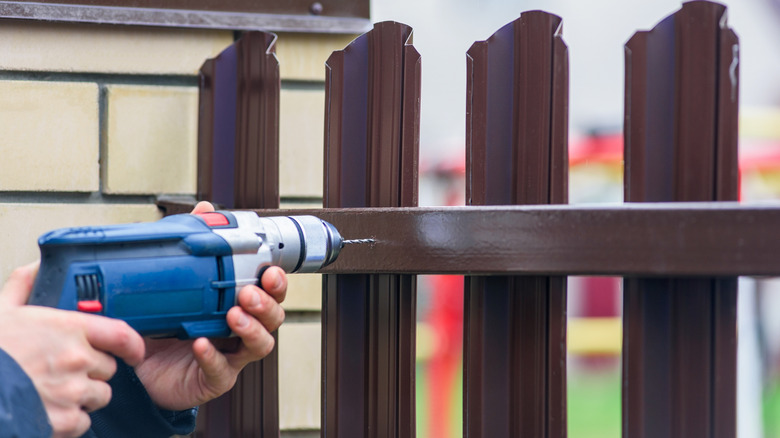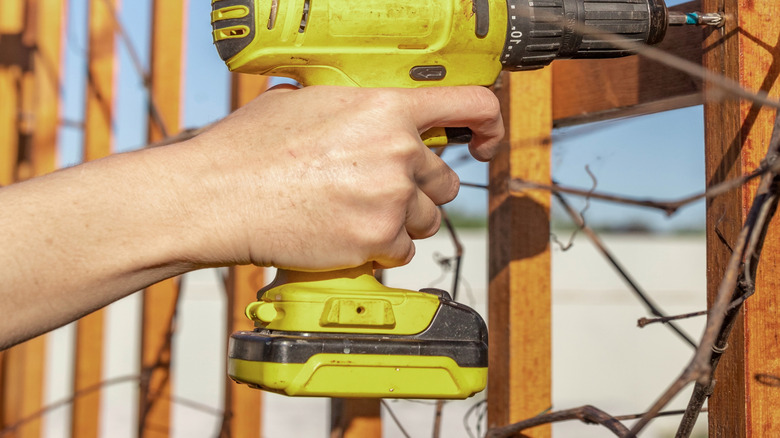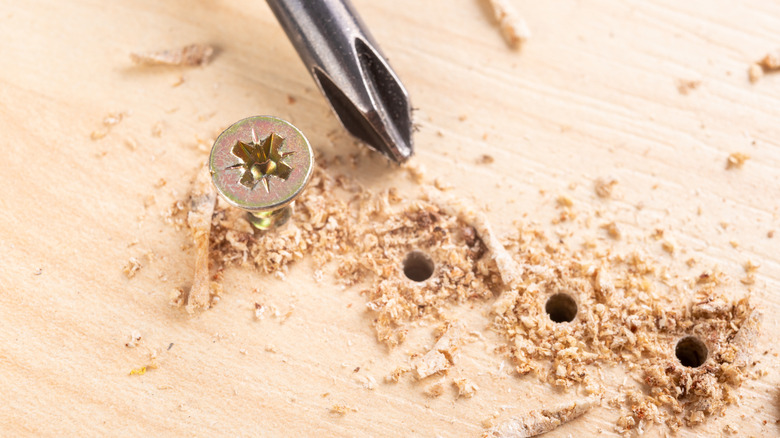When Is It A Good Idea To Drill A Pilot Hole In A Fencing Project
If you've had to follow any DIY video or guide that involves drilling into materials, chances are you've been instructed to drill a small hole in the material before inserting in your screws. While you may not give it much thought, this step isn't something you should skip or take lightly because it can affect the ease of your fencing project as well as the longevity of your fencing material. That first hole is known as a pilot hole, and its significance is much bigger than its size. Unfortunately, one of the most common fencing project mistakes is not making that initial opening, which can set you up for certain failure in some cases. If the fence is made of hardwood or any kind of thick wood, it's a good idea to always drill a pilot hole. The same goes for screws at the edges of your fence boards and load-bearing joints.
But why are pilot holes necessary anyway? Well, they improve drilling accuracy by ensuring the screws go in a straight line and exactly where you need them. These holes also reduce the resistance often experienced when drilling in screws, making your project easier and less physically demanding. If you're dealing with wooden panels, not creating those small openings first will increase the risk of wood splitting. Pilot holes remove just enough material to make room for the screw's core and reduce pressure on the wood around the joint, preventing splits.
Types and parts of materials that absolutely need pilot holes
For people working with hardwood fencing panels like oak and teak that have a high density, it can be tough trying to drill in screws. This is due to the panels' tightly-packed fibers, which increase their resistance to screws. Completing the task requires more force, and that can lead to wood splitting, stripped screw heads, or your screw breaking entirely. In this case, you cannot skip drilling a pilot hole, as it reduces the force needed to fasten screws. Laminate wood also needs pilot holes because it can be difficult to drill a screw into its smooth and flat surface.
If your fence boards are so thick that they require longer screws, you should drill a pilot hole. That's because these longer screws require more force to fasten, and more force increases the chance of wood splits for wooden boards or broken screws so it's important to take a precautionary step.
Regardless of the type of wood you use, some parts of fence boards are prone to splitting, such as the edges and end-grain of the material. For the end-grain, they're the weakest part of the board, so they don't do well under pressure. Drilling screws close to the edges wedges apart the wood fibers in a small area, which can lead to splits. As such, drilling the perfect pilot hole in those areas would help prevent these pressure problems.
More tips on drilling pilot holes for your fencing project
However, it's not always the type or part of the wood that determines when a pilot hole is needed. In other cases, there is a simple need for accurate and precise alignment. For instance, the attachment of rails or panels to fence posts requires precision since these posts are load-bearing joints, and their installation affects the structural strength of your fences. Pilot holes would help secure the screws, keeping them tight and stable. These holes are also required if you're attaching wooden fence panels to metal posts using brackets.
While pilot holes are often necessary, there are times when drilling first is overkill. Softwoods like untreated pine or spruce, especially in thinner widths, are forgiving enough that you can often drive screws directly without splitting. This changes if the wood is treated though, because it can be so similar to hardwood that it makes drilling difficult. Self-tapping screws, with their sharp tips and aggressive threads, are designed to displace wood fibers without pre-drilling. This makes them ideal for quick fencing jobs where speed matters.
Another exception is rough construction fencing where perfection isn't the goal — think temporary livestock fencing or garden borders that don't need to last decades. If aesthetics and long-term durability aren't priorities, you can usually get away with skipping pilot holes. In these cases, a simple chapstick hack could help prevent wood splitting.


